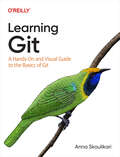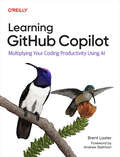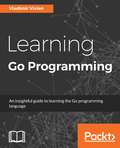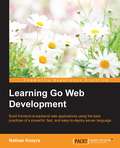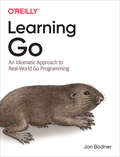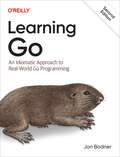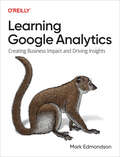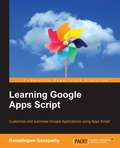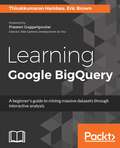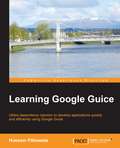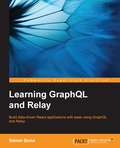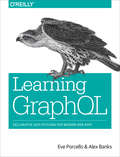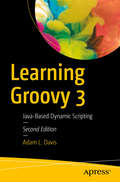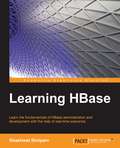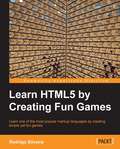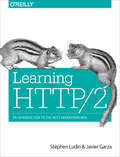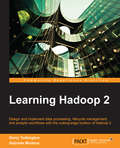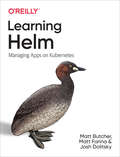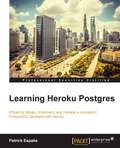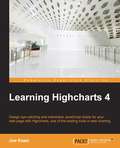- Table View
- List View
Learning Geospatial Analysis with Python: Understand GIS fundamentals and perform remote sensing data analysis using Python 3.7, 3rd Edition
by Joel LawheadLearn the core concepts of geospatial data analysis for building actionable and insightful GIS applications Key Features Create GIS solutions using the new features introduced in Python 3.7 Explore a range of GIS tools and libraries such as PostGIS, QGIS, and PROJ Learn to automate geospatial analysis workflows using Python and Jupyter Book Description Geospatial analysis is used in almost every domain you can think of, including defense, farming, and even medicine. With this systematic guide, you'll get started with geographic information system (GIS) and remote sensing analysis using the latest features in Python. This book will take you through GIS techniques, geodatabases, geospatial raster data, and much more using the latest built-in tools and libraries in Python 3.7. You'll learn everything you need to know about using software packages or APIs and generic algorithms that can be used for different situations. Furthermore, you'll learn how to apply simple Python GIS geospatial processes to a variety of problems, and work with remote sensing data. By the end of the book, you'll be able to build a generic corporate system, which can be implemented in any organization to manage customer support requests and field support personnel. What you will learn Automate geospatial analysis workflows using Python Code the simplest possible GIS in just 60 lines of Python Create thematic maps with Python tools such as PyShp, OGR, and the Python Imaging Library Understand the different formats that geospatial data comes in Produce elevation contours using Python tools Create flood inundation models Apply geospatial analysis to real-time data tracking and storm chasing Who this book is for This book is for Python developers, researchers, or analysts who want to perform geospatial modeling and GIS analysis with Python. Basic knowledge of digital mapping and analysis using Python or other scripting languages will be helpful.
Learning Gerrit Code Review
by Luca MilanesioA practical and a fast paced guide that gives you all the information you need to make software development more cooperative and social. This book is written for team leaders and developers who wish to reap the benefit of Gerrit and improve collaboration by introducing code review practices.
Learning Git: A Hands-On and Visual Guide to the Basics of Git
by Anna SkoulikariThis book teaches Git in a simple, visual, and tangible manner so that you can build a solid mental model of how Git version control works. Through the use of color, storytelling, and hands-on exercises, you will learn to use this tool with confidence.The information is introduced incrementally so that you don't get bogged down with unknown terms or concepts. Learning Git is ideal for anyone who needs to use Git for personal or professional projects: coding bootcamp students, junior developers, data professionals, and technical writers, to name just a few!This book covers how to:Download Git and initialize a local repositoryAdd files to the staging area and make commitsCreate, switch, and delete branchesMerge and rebase branchesWork with remote repositories including cloning, pushing, pulling, and fetchingUse pull requests to collaborate with others
Learning GitHub Actions: Automation and Integration of CI/CD with GitHub
by Brent LasterAutomate your software development processes with GitHub Actions, the continuous integration and continuous delivery platform that integrates seamlessly with GitHub. With this practical book, open source author, trainer, and DevOps director Brent Laster explains everything you need to know about using and getting value from GitHub Actions. You'll learn what actions and workflows are and how they can be used, created, and incorporated into your processes to simplify, standardize, and automate your work in GitHub.This book explains the platform, components, use cases, implementation, and integration points of actions, so you can leverage them to provide the functionality and features needed in today's complex pipelines and software development processes. You'll learn how to design and implement automated workflows that respond to common events like pushes, pull requests, and review updates. You'll understand how to use the components of the GitHub Actions platform to gain maximum automation and benefit.With this book, you will:Learn what GitHub Actions are, the various use cases for them, and how to incorporate them into your processesUnderstand GitHub Actions' structure, syntax, and semanticsAutomate processes and implement functionalityCreate your own custom actions with Docker, JavaScript, or shell approachesTroubleshoot and debug workflows that use actionsCombine actions with GitHub APIs and other integration optionsIdentify ways to securely implement workflows with GitHub ActionsUnderstand how GitHub Actions compares to other options
Learning GitHub Copilot: Multiplying Your Coding Productivity Using AI
by Brent LasterSupercharge your coding productivity with generative AI using GitHub Copilot. In this practical guide, author Brent Laster guides you through using generative AI for writing better code faster, generating tests with ease, creating polished documentation at any stage of development, and more. You'll also explore advanced uses—like leveraging Copilot's Agent functionality to add features autonomously and reviewing pull requests automatically. Learning GitHub Copilot is for developers, testers, DevOps engineers, and software professionals at all levels. Alongside the fundamentals, you’ll dive into Copilot Edits, Agent mode, and Copilot Vision. You’ll also learn how to create your own Copilot extensions to expand its capabilities. Whether you’re working in Python, JavaScript, or any other language, this book helps you confidently integrate AI into your development workflow. Harness real-time AI insights to explore and understand unfamiliar code and algorithms Master inline completions and the chat interface to automate common tasks Turn natural language prompts into complete functions, tests, and docs quickly and easily Optimize AI results with context and prompts to get targeted solutions Streamline feature development and refactors with AI assistance in your IDE
Learning Go Programming
by Vladimir VivienAn insightful guide to learning the Go programming language About This Book * Insightful coverage of Go programming syntax, constructs, and idioms to help you understand Go code effectively * Push your Go skills, with topics such as, data types, channels, concurrency, object-oriented Go, testing, and network programming * Each chapter provides working code samples that are designed to help reader quickly understand respective topic Who This Book Is For If you have prior exposure to programming and are interested in learning the Go programming language, this book is designed for you. It will quickly run you through the basics of programming to let you exploit a number of features offered by Go programming language. What You Will Learn * Install and configure the Go development environment to quickly get started with your first program. * Use the basic elements of the language including source code structure, variables, constants, and control flow primitives to quickly get started with Go * Gain practical insight into the use of Go's type system including basic and composite types such as maps, slices, and structs. * Use interface types and techniques such as embedding to create idiomatic object-oriented programs in Go. * Develop effective functions that are encapsulated in well-organized package structures with support for error handling and panic recovery. * Implement goroutine, channels, and other concurrency primitives to write highly-concurrent and safe Go code * Write tested and benchmarked code using Go's built test tools * Access OS resources by calling C libraries and interact with program environment at runtime In Detail The Go programming language has firmly established itself as a favorite for building complex and scalable system applications. Go offers a direct and practical approach to programming that let programmers write correct and predictable code using concurrency idioms and a full-featured standard library. This is a step-by-step, practical guide full of real world examples to help you get started with Go in no time at all. We start off by understanding the fundamentals of Go, followed by a detailed description of the Go data types, program structures and Maps. After this, you learn how to use Go concurrency idioms to avoid pitfalls and create programs that are exact in expected behavior. Next, you will be familiarized with the tools and libraries that are available in Go for writing and exercising tests, benchmarking, and code coverage. Finally, you will be able to utilize some of the most important features of GO such as, Network Programming and OS integration to build efficient applications. All the concepts are explained in a crisp and concise manner and by the end of this book; you would be able to create highly efficient programs that you can deploy over cloud. Style and approach The book is written to serve as a reader-friendly step-by-step guide to learning the Go programming language. Each topic is sequentially introduced to build on previous materials covered. Every concept is introduced with easy-to-follow code examples that focus on maximizing the understanding of the topic at hand.
Learning Go Web Development
by Nathan KozyraBuild frontend-to-backend web applications using the best practices of a powerful, fast, and easy-to-deploy server language About This Book * Build a fully-featured REST API to enable client-side single page apps * Utilize TLS to build reliable and secure sites * A quick guide that provides everything a developer needs to know to build end-to-end web applications in Go Who This Book Is For This book is intended for experienced programmers with minimal-to-moderate exposure to the Go language. If you have some fundamentals down, but are looking for more detail when it comes to using Go for the web, this is the book for you. What You Will Learn * Create a listening web server * Route requests * Implement SSL/TLS * Use Go's logic-less templates * Implement caching for maximum performance * Use sessions and cookies * Utilize security best practices to keep users and data safe * Connect to data sources * Create a RESTful API In Detail Go is an open source programming language that makes it easy to build simple, reliable, and efficient software. It is a statically typed language with syntax loosely derived from that of C, adding garbage collection, type safety, some dynamic-typing capabilities, additional built-in types such as variable-length arrays and key-value maps, and a large standard library. Learning Go Web Development is a start-to-finish walkthrough of the topics most critical to anyone building a new web application. Whether it's keeping your application secure, connecting to your database, enabling token-based authentication, or utilizing logic-less templates, this book has you covered. You'll begin by learning about routing requests and implementing SSL. Moving on, you'll get to know about practices to keep users' data safe. By the end of the book, you will be able to build robust, secure, and fully-featured applications for the web. Style and approach This concise book demonstrates by doing. You'll build a component every step of the way and in the end, will have a blogging platform that can be used for personal experimentation and augmented to be used in production.
Learning Go: An Idiomatic Approach To Real-world Go Programming
by Jon BodnerGo is rapidly becoming the preferred language for building web services. While there are plenty of tutorials available that teach Go's syntax to developers with experience in other programming languages, tutorials aren't enough. They don't teach Go's idioms, so developers end up recreating patterns that don't make sense in a Go context. This practical guide provides the essential background you need to write clear and idiomatic Go.No matter your level of experience, you'll learn how to think like a Go developer. Author Jon Bodner introduces the design patterns experienced Go developers have adopted and explores the rationale for using them. You'll also get a preview of Go's upcoming generics support and how it fits into the language.Learn how to write idiomatic code in Go and design a Go projectUnderstand the reasons for the design decisions in GoSet up a Go development environment for a solo developer or teamLearn how and when to use reflection, unsafe, and cgoDiscover how Go's features allow the language to run efficientlyKnow which Go features you should use sparingly or not at all
Learning Go: An Idiomatic Approach to Real-World Go Programming
by Jon BodnerGo has rapidly become the preferred language for building web services. Plenty of tutorials are available to teach Go's syntax to developers with experience in other programming languages, but tutorials aren't enough. They don't teach Go's idioms, so developers end up recreating patterns that don't make sense in a Go context. This practical guide provides the essential background you need to write clear and idiomatic Go.No matter your level of experience, you'll learn how to think like a Go developer. Author Jon Bodner introduces the design patterns experienced Go developers have adopted and explores the rationale for using them. This updated edition also shows you how Go's generics support fits into the language.This book helps you:Write idiomatic code in Go and design a Go projectUnderstand the reasons behind Go's design decisionsSet up a Go development environment for a solo developer or teamLearn how and when to use reflection, unsafe, and cgoDiscover how Go's features allow the language to run efficientlyKnow which Go features you should use sparingly or not at allUse Go's tools to improve performance, optimize memory usage, and reduce garbage collectionLearn how to use Go's advanced development tools
Learning Google Analytics: Creating Business Impact and Driving Insights
by Mark EdmondsonWhy is Google Analytics 4 the most modern data model available for digital marketing analytics? Because rather than simply report what has happened, GA4's new cloud integrations enable more data activation—linking online and offline data across all your streams to provide end-to-end marketing data. This practical book prepares you for the future of digital marketing by demonstrating how GA4 supports these additional cloud integrations.Author Mark Edmondson, Google Developer Expert for Google Analytics and Google Cloud, provides a concise yet comprehensive overview of GA4 and its cloud integrations. Data, business, and marketing analysts will learn major facets of GA4's powerful new analytics model, with topics including data architecture and strategy, and data ingestion, storage, and modeling. You'll explore common data activation use cases and get guidance on how to implement them.You'll learn:How Google Cloud integrates with GA4The potential use cases that GA4 integrations can enableSkills and resources needed to create GA4 integrationsHow much GA4 data capture is necessary to enable use casesThe process of designing dataflows from strategy though data storage, modeling, and activation
Learning Google Apps Script
by Ramalingam GanapathyCustomize and automate Google Applications using Apps Script About This Book * Gain insight into customizing and automating Google applications with JavaScript * Create add-ons for Google Sheets, Docs, or Forms; automate your workflow; integrate with external APIs; and more. * A step-by-step guide to building real-world solutions Who This Book Is For Newbies to google apps script but having practical experience in Javascript. What You Will Learn * Learn about the Google Apps script platform and work with scripts to develop Google apps * Create custom menus and dialogs * Parse and send emails * Generate Google calendar events * Build Translator and RSS reader applications * Develop interactive web pages * Design interactive web-forms * Form a workflow application In Detail Google Apps Script is a cloud-based scripting language based on JavaScript to customize and automate Google applications. Apps Script makes it easy to create and publish add-ons in an online store for Google Sheets, Docs, and Forms. It serves as one single platform to build, code, and ultimately share your App on the Web store. This book begins by covering the basics of the Google application platform and goes on to empower you to automate most of the Google applications. You will learn the concepts of creating a menu, sending mails, building interactive web pages, and implementing all these techniques to develop an interactive Web page as a form to submit sheets You will be guided through all these tasks with plenty of screenshots and code snippets that will ensure your success in customizing and automating various Google applications This guide is an invaluable tutorial for beginners who intend to develop the skills to automate and customize Google applications Style and approach An easy-to-follow yet comprehensive guide, filled with many code examples and screenshots illustrating various Google Apps scripts.
Learning Google BigQuery: A beginner's guide to mining massive datasets through interactive analysis
by Eric Brown Jason Morris Ruben Oliva Ramos Thirukkumaran Haridass Mikhail BerlyantKey Features Get started with BigQuery API and write custom applications using it Learn how BigQuery API can be used for storing, managing, and query massive datasets with ease A practical guide with examples and use-cases to teach you everything you need to know about Google BigQuery Book Description Google BigQuery is a popular cloud data warehouse for large-scale data analytics. This book will serve as a comprehensive guide to mastering BigQuery, and how you can utilize it to quickly and efficiently get useful insights from your Big Data. You will begin with getting a quick overview of the Google Cloud Platform and the various services it supports. Then, you will be introduced to the Google BigQuery API and how it fits within in the framework of GCP. The book covers useful techniques to migrate your existing data from your enterprise to Google BigQuery, as well as readying and optimizing it for analysis. You will perform basic as well as advanced data querying using BigQuery, and connect the results to various third party tools for reporting and visualization purposes such as R and Tableau. If you're looking to implement real-time reporting of your streaming data running in your enterprise, this book will also help you. This book also provides tips, best practices and mistakes to avoid while working with Google BigQuery and services that interact with it. By the time you're done with it, you will have set a solid foundation in working with BigQuery to solve even the trickiest of data problems. What you will learn Get a hands-on introduction to Google Cloud Platform and its services Understand the different data types supported by Google BigQuery Migrate your enterprise data to BigQuery and query it using the legacy and standard SQL techniques Use partition tables in your project and query external data sources and wild card tables Create tables and data sets dynamically using the BigQuery API Perform real-time inserting of records for analytics using Python and C# Visualize your BigQuery data by connecting it to third party tools such as Tableau and R Master the Google Cloud Pub/Sub for implementing real-time reporting and analytics of your Big Data
Learning Google Guice
by Hussain PithawalaThis book is a practical, hands-on guide that covers everything you need to know about application development in Java with dependency injection using Google Guice.Learning Google Guice is for architects and lead programmers who want to know more about Google Guice and how to leverage its more advanced features. It is assumed that readers will have a basic knowledge of dependency injection; however, this is not an obligation.
Learning GraphQL and Relay
by Samer BunaBuild data-driven React applications with ease using GraphQL and Relay About This Book * Take your React applications to the next level with GraphQl and Relay * Explore the concepts of data fetching, data handling, and more * Learn to deploy your applications, which are compliant with GraphQl and Relay Who This Book Is For This book is perfect for those who have no prior experience or familiarity with Relay and/or GraphQL. You should be comfortable writing NodeJS applications on a MongoDB database with REST APIs as well as applications on the client-side using React and ES2015. What You Will Learn * Understand what problem GraphQL solves and how it differs from traditional REST architectures * Create a GraphQL server * Develop modular and maintainable GraphQL code * Grasp how to define GraphQL mutations * Comprehend how to define GraphQL queries * Modify a GraphQL server to be Relay-compliant * Develop a Relay client-side application with ReactJS that consumes a GraphQL endpoint In Detail There's a new choice for implementing APIs - the open source and Facebook-created GraphQL specification. Designed to solve many of the issues of working with REST, GraphQL comes alongside RelayJS, a React library for querying a server that implements the GraphQL specification. This book takes you quickly and simply through the skills you need to be able to build production ready applications with both GraphQL and RelayJS. Beginning with a solid foundation in the GraphQl specification, this book swiftly moves to how a data layer can be implemented for your web application using Relay. Get to grips with GraphQL and Relay concepts creating data containers, data masking, and more as your progress towards building a production-ready application. Style and approach This book serves as the answer to every question related to data-driven app development with React. Using real-world examples, this book will show you how to enhance the functionality of React apps by introducing efficient data handling features within the app.
Learning GraphQL: Declarative Data Fetching for Modern Web Apps
by Alex Banks Eve PorcelloWhy is GraphQL the most innovative technology for fetching data since Ajax? By providing a query language for your APIs and a runtime for fulfilling queries with your data, GraphQL presents a clear alternative to REST and ad hoc web service architectures. With this practical guide, Alex Banks and Eve Porcello deliver a clear learning path for frontend web developers, backend engineers, and project and product managers looking to get started with GraphQL.Youâ??ll explore graph theory, the graph data structure, and GraphQL types before learning hands-on how to build a schema for a photo-sharing application. This book also introduces you to Apollo Client, a popular framework you can use to connect GraphQL to your user interface.Explore graph theory and review popular graph examples in use todayLearn how GraphQL applies database querying methods to the internetCreate a schema for a PhotoShare application that serves as a roadmap and a contract between the frontend and backend teamsUse JavaScript to build a fully functioning GraphQL service and Apollo to implement a clientLearn how to prepare GraphQL APIs and clients for production
Learning Groovy 3: Java-Based Dynamic Scripting
by Adam L. DavisStart building powerful apps that take advantage of the dynamic scripting capabilities of the Groovy language, including what's new in Groovy version 3.0. This book covers Groovy fundamentals, such as installing Groovy, using Groovy tools, and working with the Groovy Development Kit (GDK). You'll also learn more advanced aspects of Groovy, such as using Groovy design patterns, writing DSLs in Groovy, and taking advantage of Groovy's functional programming features.Also, Learning Groovy 3 has been updated to Groovy 3.0 to include the new Parrot parser which was extended to support additional syntax options and language features. It also includes coverage of Groovydoc, which allows you to embed Groovydoc comments in various ways. And, this book covers how Groovy supports Java type annotations and more.There is more to Groovy than the core language, so Learning Groovy 3, Second Edition covers the extended Groovy ecosystem. You'll see how to harness Gradle (Groovy's build system), Grails (Groovy's web application framework), Spock (Groovy's testing framework), and Ratpack (Groovy's reactive web library).What You Will LearnGrasp Groovy fundamentals, including the GDK Master advanced Groovy, such as writing Groovy DSLsDiscover functional programming in GroovyWork with GPars, the built-in concurrency libraryUse Gradle, the build systemMaster Grails, the web application frameworkWork with Spock, the testing frameworkHarness Ratpack, the reactive web libraryWho This Book Is ForThose with a Java background, though anyone with basic programming skills can benefit from it. This book is a data-filled, yet easy-to-digest tour of the Groovy language and ecosystem.
Learning Grunt
by Douglas ReynoldsMonitor and automate complex JavaScript tasks and processes by obtaining a practical understanding of Grunt About This Book * Gain a solid knowledge of Grunt to achieve better process management by improving consistency, productivity, reliability, and quality of code * Install, configure, and use plugins into your project with this hands-on guide * This step-by-step tutorial will walk you through practical examples of workflow automation Who This Book Is For If you are a JavaScript developer and want to learn project monitoring and automation using Grunt, then this book is for you. Basic knowledge of Node.js and Angular.js is assumed. However, no previous experience using Grunt.js is required. What You Will Learn * Install and configure Grunt and its dependencies such as Node.js and Node Package Manager (NPM) * Create a sample application using Angular.JS * Configure plugins to perform various tasks that will benefit your project * Explore the task-specific methods available through the Grunt API such as configuration, externals, events, and logging * Set up tasks to automate the build process of the simple contact application * Build, test, and refine a sample project * Get general tips, tricks, and troubleshooting strategies to identify and solve common issues in Grunt * Advance your knowledge of Grunt with concepts such as configuration variables and test automation In Detail With the increasing focus on task automation, the Grunt task runner is a vast platform that allows you to incorporate automation into your workflows. At the outset, you will learn how to use Node.js and NMP through an example. You will then find out how to build a sample app and the development environment for it. You will further delve into the implementation of Grunt plugins and the configuration of Grunt tasks. Furthermore, you will explore the various methods and packages for workflow automation. The final chapter will cover some advanced concepts, such as configuration variables and how to create a Grunt plugin. By the end of the book, you will have gained the fundamentals of Grunt and progressed through advanced concepts, including building a Grunt plugin. Style and approach This book is an easy-to-follow, step-by-step tutorial that provides explanations and examples of deploying Grunt from scratch.
Learning HBase
by Shashwat ShriparvIf you are an administrator or developer who wants to enter the world of Big Data and BigTables and would like to learn about HBase, this is the book for you.
Learning HTML5 by Creating Fun Games
by Rodrigo SilveiraBy teaching HTML5 by developing exciting games, the reader will see concrete applications for each of the concepts, and will also have a powerful deliverable at the end of each chapter - a fully functional game. We learn the various concepts using very abstract examples - how to model animals, foods, or fictitious machines. This makes learning and understanding a lot easier, and much more enjoyable.If you are are looking to get a good grounding in how to use the new awesome technology that is HTML5, this book is for you. Basic knowledge of HTML and/or HTML5 is welcome, but optional. The book is a friendly and exciting reference for beginners.
Learning HTTP/2: A Practical Guide for Beginners
by Javier Garza Stephen LudinWhat can your organization gain by adopting HTTP/2? How about faster, simpler, and more robust websites and applications? This practical guide demonstrates how the latest version of the Hypertext Transfer Protocol can dramatically improve website and application performance. You’ll take a deep dive into HTTP/2 details, and learn how this updated protocol is changing the web landscape.HTTP/1.1 has been the primary means of communicating data across the web for the past 20 years, but the level of interaction today has gone well beyond what people envisioned in 1997. With this book, authors Stephen Ludin and Javier Garza show you how HTTP/2 will help speed the execution of modern sites and applications.With this book, you’ll explore:Performance challenges that led to the HTTP upgradeHTTP/2 in a nutshell, including benefits and transition methodsExisting best practices and hacks to improve web performanceHTTP/2 support for browsers, servers, proxies, and content delivery networksHow the performance of sites using HTTP/2 compares to their HTTP/1.1 experienceHTTP/2’s effect on specific issues such as latency, packet loss, and Time to First Byte (TTFB)HTTP/2’s effect on specific issues such as latency, packet loss, and Time to First Byte (TTFB)
Learning Hadoop 2
by Garry Turkington Gabriele ModenaIf you are a system or application developer interested in learning how to solve practical problems using the Hadoop framework, then this book is ideal for you. You are expected to be familiar with the Unix/Linux command-line interface and have some experience with the Java programming language. Familiarity with Hadoop would be a plus.
Learning Haskell Data Analysis
by James ChurchIf you are a developer, analyst, or data scientist who wants to learn data analysis methods using Haskell and its libraries, then this book is for you. Prior experience with Haskell and a basic knowledge of data science will be beneficial.
Learning Helm
by Matt Butcher Matt Farina Josh DolitskyGet up to speed with Helm, the preeminent package manager for the Kubernetes container orchestration system. This practical guide shows you how to efficiently create, install, and manage the applications running inside your containers. Helm maintainers Matt Butcher, Matt Farina, and Josh Dolitsky explain how this package manager fits into the Kubernetes ecosystem and provide an inside look at Helm's design and best practices.More than 70% of the organizations that work with Kubernetes use Helm today. While the Helm community provides thousands of packages, or charts, to help you get started, this book walks developers and DevOps engineers through the process of creating custom charts to package applications. If you have a working understanding of Kubernetes, you're ready to go.Explore primary features including frequently used Helm commandsLearn how to build and deploy Helm charts from scratchUse Helm to manage complexity and achieve repeatable deploymentsPackage an application and its dependencies for easy installationManage the entire lifecycle of applications on KubernetesExplore ways to extend Helm to add features and functionalityLearn features for testing, handling dependencies, and providing security
Learning Heroku Postgres
by Patrick EspakeLearning Heroku Postgres is targeted at developers and database admins. Even if you're new to Heroku Postgres, you'll be able to master both the basic as well as advanced features of Heroku Postgres. Since Heroku Postgres is incredibly user-friendly, no previous experience in computer coding or programming is required.
Learning Highcharts
by Joe KuanA complete practical and comprehensive tutorial with clear and step-by-step instructions along with many examples. It's packed with examples, code samples and practical tips in a no-nonsense way. This book is both for beginners and advanced web developers who need to create interactive charts for their web applications. It primarily targets JavaScript Web developers who want to use the Highcharts library to prepare interactive and professional-quality charts and graphs for their applications quickly and easily. Prior experience with JavaScript is assumed.


